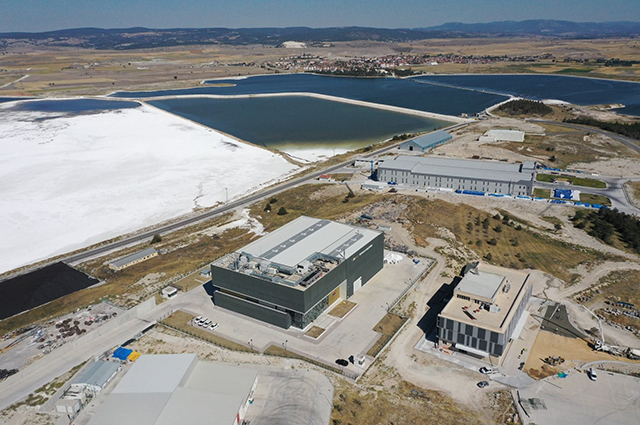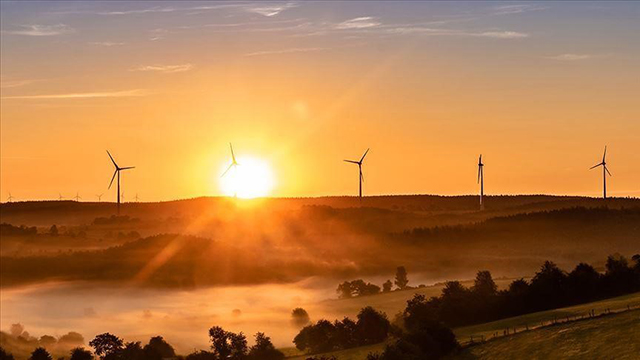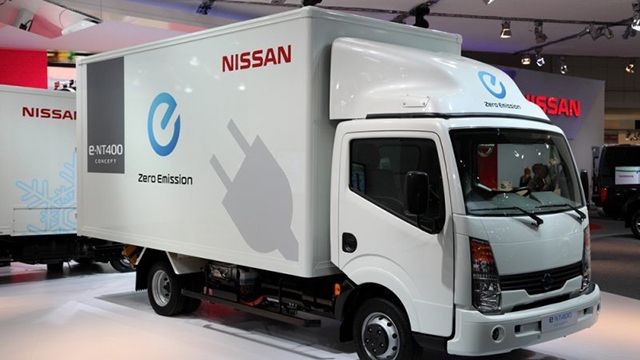
Turkey is set to begin producing lithium for the first time in a plant currently under construction in the central province of Eskisehir, the country’s energy and natural resources minister announced.
“We will start the production of lithium in Turkey for the first time with the plant of which construction began this year,” Fatih Donmez told reporters on the sidelines of a visit to Eti Maden Technology Development Center on Monday.
The element is used in cell and battery technologies.
Turkey's inroad in lithium production will start on a small scale of 10 tons per year, but this is expected to rise to nearly 500 tons in the next two to three years, according to Donmez.
Given that Turkey currently imports nearly 1,200 tons of lithium annually, it represents a considerable volume in domestic production and in import savings, which Donmez said are more expensive. In a later tweet, Donmez said the country would start local production of lithium by the end of the year.
“We have started the boron lithium production attack. Domestic-made lithium will be used in the batteries of electric cars, phones and tablets. We will start production at the end of the year,” the minister said.
During his visit to the tech center of the country's official mining company, Eti Maden, Donmez also stressed that the lithium will be used in critical technologies in cell and software for electric vehicles, particularly in Turkey's first domestically produced all-electric vehicle.
“We will also be using the lithium batteries produced here in the domestically made car,” Donmez said. The vehicle has been developed by Turkey's Automobile Joint Venture Group (TOGG), a consortium of five major Turkish companies.
Mass production is expected to start in 2022 with TOGG making five different models – an SUV, a sedan, a C-hatchback, a B-SUV and a B-MPV – by 2030. Turkey in July this year laid the foundation of the factory in the northwestern province of Bursa where the cars will be manufactured. Once completed, the facility will have the capacity to produce 175,000 vehicles per year. Earlier this month, the country also laid the foundation of its first lithium-ion battery production facility in the central province of Kayseri.
The sprawling facility, comprising of a closed area of 24,000 square meters (nearly 6 acres) in an organized industrial zone in the eastern outskirts of the city of Kayseri, is planned for completion next year.
The facility will be established by Aspilsan Energy, which is owned by the Turkish Armed Forces Foundation with a 98% share. The lithium-ion battery production facility looks to lower the country’s dependence on foreign resources in the field of energy storage.
Source: Daily Sabah

Energy efficiency deployment in Turkey could save the equivalent electricity consumption of 18 million households in 2030, according to a new report published by Istanbul-based SHURA Energy Transition Center on Tuesday.
The report, titled The Most Economical Solution for Turkey's Power System: Energy Efficiency and Business Models was carried out based on two scenarios, Baseline and SHURA, in which the extent of energy-efficient deployment technologies differ.
The Baseline scenario is based on Turkey's Electricity Demand Projections Report prepared by the Energy and Natural Resources Ministry, while the SHURA scenario assesses the potential of energy efficiency across 21 electricity end-use areas and accounts for an accelerated deployment of energy efficiency technologies, which would be enabled by the implementation of the proposed energy efficiency solutions.
According to the SHURA scenario, with the deployment of energy efficiency technologies, Turkey's total annual electricity demand in 2030 reduces to 416.9 terawatt-hours (TWh) down from the Baseline scenario of 459.2 TWh.
Net savings in electricity demand amounts to 42.3 TWh, equivalent to the electricity demand of 18 million households or the combined electricity consumption of textiles and basic metal industries in Turkey.
"Most of these savings will be achieved through technology and measures to increase energy efficiency. Additionally, significant gains can be achieved through methods such as energy management systems and the optimization of energy consumption on the demand side," the report said.
According to the report, 82% of the total energy savings in 2030 would be lower than the foreseen electricity tariff in the same year. "Energy efficiency technologies that cost less than the electricity tariff stands out as lighting, industrial heating and cooling, variable speed drive applications, distributed production technologies, equipment and process improvements in electric arc furnaces and more efficient applications in the cement sector," the report highlighted.
In the SHURA scenario, the annual CO2 emissions in the electricity sector reduce by 25.1 million tonnes in 2030, compared to the Baseline scenario, which means limiting the growth in CO2 emissions of the electricity sector to 5% compared to 2018 levels of 150 million tonnes.
The savings potential determined in the SHURA scenario reduces demand for electricity generated from natural gas by almost half as well as reducing the dependence on imported coal by 10% by 2030, compared to the Baseline scenario.
While natural gas consumption in power plants declines to 8.7 billion cubic meters with a decrease in electricity demand in the SHURA scenario, this reduction is estimated to provide about $2.4 billion by 2030.
The coal consumption of power plants in 2030 decreases by 3% to 108.2 million tonnes under the SHURA scenario, while with the savings from the reduced dependence on imported coal, the total benefit is equivalent to $2.7 billion per year.
The SHURA scenario is estimated to create an investment need of $54 billion in the 2020-2030 period, including $30 billion for energy efficiency, $11 billion for distributed energy resources, and $13 billion for electrification, including heat pumps.
In particular, according to the report, these investments will certainly play a big role in reducing dependence on foreign trade of manufactured technologies and equipment, allowing them to be produced in Turkey.
"The increase in investments and domestic production will be reflected as new opportunities for employment. Procuring the necessary technologies and services for an industry with more renewable energy shares and increasing energy efficiency will carry the current employment levels up,” the report said.
Turkey's export potential will be supported by the industrial sector providing a much cleaner source of energy, lower costs and fewer emissions in the value chain of products on the market, it added.
Moreover, according to the report, in addition to economic benefits, energy efficiency will also contribute greatly to the reduction of air pollutant emissions to which a high proportion of Turkey's population is exposed.
Source: Anadolu Agency

International Energy Agency (IEA) executive director Fatih Birol this week launched the organization’s flagship World Energy Outlook 2020 report by declaring: “Solar is the new king of the global electricity markets.”
With the international thinktank bringing forward publication of its annual report by a month, however, Birol said the study painted a far from rosy outlook for the prospects of limiting the global temperature rise to 1.5 degrees Celsius. Asked at Tuesday’s launch of the study whether global net zero emissions would be possible by mid-century, the IEA chief said only: “It is theoretically not impossible.”
The focus of the latest iteration of the IEA’s set of forecasts inevitably focuses on the Covid-19 crisis experienced by the world since the last edition, in November.
The study considers four future scenarios which hinge on the question of when the global health crisis will be contained. The ‘stated policies’ (STEPS) scenario echoes the expectations voiced by global governments that the novel coronavirus will be contained next year and that the economic recovery will be complete by the end of the year. That STEPS outlook forms the basis for two more optimistic predictions: the ‘sustainable development scenario’ (SDS) builds on the stated policies prediction by envisioning adoption of legislation in line with the ideals of the Paris climate agreement and the ‘net zero by 2050’ forecast extends the scope of the SDS situation to 2050-70 to consider what would be required to hit the goal by mid century.
By contrast, the IEA’s ‘delayed recovery’ picture (DRS) posits an extended Covid-19 shock with the global economy not rebounding until 2023 and the world entering a decade of the lowest energy demand growth since the 1930s. The DRS outlook came in for relatively few mentions in either the IEA summary of the study or the official launch.
There were plenty of plaudits for solar and PV projects “which now offer some of the lowest-cost electricity ever seen,” according to the IEA. Cheap finance and ever cheaper materials costs would see solar play a big part in renewable energy contributing 80% of the expected 9% annual growth in global energy demand to 2030 under the organization’s STEPS scenario. Hydro would still dominate but there would be record years of solar deployment every year from 2022 to the end of the decade, according to the IEA.
Solar – and nuclear – would contribute even more in the more optimistic sustainable development and net-zero forecasts, driving a great need for improved grids, energy flexibility and energy storage, with India becoming the world’s biggest utility scale storage market at some point. The fact that big investment will be required to upgrade electricity grids at a time when many utilities – especially in the developing world – are in financial crisis was not lost on the authors of the IEA report.
The likelihood of Covid-19 accelerating the death throes of coal was reflected by expectations that 275 GW of coal-fired power capacity would be shuttered by 2025, including 100 GW in the U.S. and 75 GW in the EU. The 39% of the world’s electricity generated from coal last year is set to fall to 28% by 2030 under the business-as-usual STEPS scenario, or to 15% under the sustainable outlook.
There was less immediate prospect of the ‘peak oil’ which has been the subject of speculation in some quarters this year and the fortunes of gas will depend heavily on policy, according to the IEA. Clean air policy and manufacturing growth in south and east Asia could drive a 30% rise in global gas demand by 2040, the study speculates.
Tim Gould, head of energy supply outlooks and investment at the IEA, spoke at the launch of the report to point out that consumers have spent $1 trillion less on oil products this year than last year. With oil and gas values having fallen by a quarter this year, the industry has written off $50 billion of assets thus far in 2020. Gould said the 60% of oil income contributed from the transport sector in the last decade would instead shift to 60% from plastics to 2030, reflecting changes in consumer behavior.
Warning against complacency on that subject at the IEA launch event, Gould’s boss Birol said that for all the back-slapping about the rapidly rising number of electric vehicles (EVs) on roads this year, only 2.5% of new vehicle sales were electric. Set against that, some 42% of new sales were of gas-guzzling SUVs, Birol said.
Source: Pv Magazine

Up to 43% of European citizens agree that electric vehicles (EVs) are instrumental in combatting climate change, according to a study comprising 3,600 residents in six European countries.
The study, conducted by Ipsos on behalf of evBox, also comprises feedback from 600 EV drivers in Belgium, France, Germany, the Netherlands, Norway, and the UK. Driving electric first needs to shift from nice-to-have to need-to-have, especially with the next generation of (potential) EV drivers viewing access to charging and price perception as the biggest concerns, according to the study.
In all six countries except Norway, the two main barriers to not going electric are the uncertainty of the availability of publicly-accessible charging stations and the perception that EVs are still relatively expensive. Additional concerns include the amount of time required for charging sessions and the perception that EV charging costs more than fueling with petrol.
However, the majority of current EV drivers do not encounter problems during charging sessions (89%) which shows that as long as people are open to trying it out, they likely won’t look back. The majority of Europeans (63%) consider following a sustainable path as the best solution to combat climate change.
Of the surveyed, 40% say governments should only give financial aid related to the COVID-19 pandemic and to companies who are taking serious steps to reduce their ecological footprint. A large proportion of European citizens (62%) rate climate change as a highly personal matter—and 74% of people who are looking to invest in an EV or already drive one agree.
Up to 62% state that reducing CO2 emissions in transportation is important to them and roughly two out of three (potential*) EV drivers clearly link emobility to the broader theme of combating climate change.
Government policies are expected to greatly impact EV adoption in the coming years. 77% of people who are considering investing in an EV think that their government should prioritise policies that protect the environment. The transportation goal of the European Green Deal is seen as favorable by 70% of (potential*) EV drivers, and more than half say that the goal makes investing in an EV a more attractive prospect.
Current drivers of EVs prove extremely loyal when it comes to electric driving with 82% saying that they would opt for an EV again.
Source: Smart Energy International

Green hydrogen, low-carbon aviation fuel and electric trucks are among 55 clean technologies that can help the European Union to reach its goal of climate neutrality by mid-century, new research showed on Wednesday (14 October).
The research, produced by Capgemini Invent, aims to provide a guide for policymakers and investors, and identified technologies and projects the EU could invest in using money from its budget and recovery fund to help the region’s economies bounce back from the pandemic.
It looked at 200 projects and chose 55 technologies as “ripe for investment” that could deliver results quickly and at scale up to 2030 and 2050.
Combined, they could create a market of net-zero goods and services totalling up to €790 billion a year and reduce emissions by 871 million tonnes.
The technologies will require around €144 billion of public and private investment a year and support 12.7 million jobs but for every €1 invested in this portfolio, it could generate €9 of future turnover in European markets by 2050.
The projects chosen include: solar module gigafactories; large-scale floating offshore wind; large-scale green hydrogen production; grid development to enable 100% renewable power; and direct carbon capture technology, the report said.
For the industrial sector, projects include materials to replace concrete; green hydrogen production in refineries, carbon capture for steel manufacturing, switch to low-carbon fuels for heat industry processes.
For transport, projects include giga-scale production facilities for low-carbon fuel production for aviation, green ammonia-fuelled vessels and infrastructure for shipping, electrification of trucks and electric vehicle charging infrastructure.
In July, the European Commission unveiled a €750 billion fund to aid recovery from the pandemic, which was in addition to a more than €1 trillion package of long-term budget. Of the combined €1.83 trillion, 30% is earmarked for climate goals.
Source: EURACTIV

A group of trade organisations and solar companies have launched a new initiative that aims to improve diversity and inclusion in the industry.
The 'Renewables Forward' partnership will see stakeholders share corporate practices and policies as well as invest in under-resourced and minority communities in the US. The goal is to identify tangible ways to collaborate and drive a larger industrywide partnership between CEOs and solar organisations.
Founding members include Capital Dynamics, Cypress Creek Renewables, EDF Renewables, Generate Capital, Mosaic, Nautilus Solar Energy, New Columbia Solar, Nextracker, Sol Systems and Volt Energy, as well as the Solar Energy Industries Association and The Solar Foundation.
“From a mission perspective, the lack of diversity in solar means that whole segments of the American population are simply not participating in climate solutions and are being left out of the economic opportunities that these jobs create,” said Dan Shugar, CEO of Nextracker. “Words are good, but we are overdue in our industry to do better in terms of minority and gender representation.”
Renewables Forward’s initial efforts include coordinating an educational and fundraising programme to support US civil rights organisations the National Association for the Advancement of Colored People, The Southern Poverty Law Center and the Urban League.
Gilbert Campbell, CEO of solar project developer Volt Energy, said: “Our diversity issue is not simply a hiring problem, but an issue of education, access, political voice, environmental impact, community protection and sustainability.
“We cannot commit to building a better, more sustainable future without committing both to address the inequities of the past and to build a solution that elevates opportunity for all Americans.”
Source: PvTech
World Energy Outlook 2020
The World Energy Outlook 2020 report of the International Energy Agency examines the next 10 years of energy markets through 4 different scenarios.
Please click here to read the full report.

